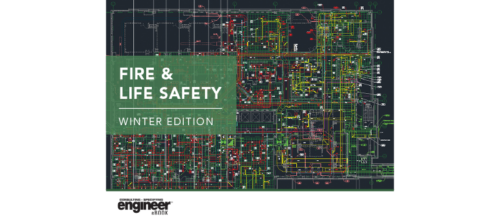Best practices for designing smoke control systems
By incorporating NFPA 92 with best practices, fire protection engineers can successfully design smoke control systems for buildings
Learning objectives
- Learn about common challenges that arise in the design of smoke control systems.
- Identify approaches that may be taken to address design fundamentals, smoke management calculation procedures, building equipment and controls and smoke control system documentation and testing.
- Review how best practices were applied on a case study high-rise building.
The 2018 edition of NFPA 92: Standard for Smoke Control Systems provides guidance pertaining to the design, installation, acceptance testing, operation and ongoing periodic testing of smoke control systems. Since the inception of the NFPA Technical Committee on Smoke Management in 1985, there has been a steady evolution in the approaches, tools and implementation of smoke control systems in buildings.
This progress has been fed by readily available computational resources, new data for design fires and materials, as well as the collective experience derived from designing, installing and operating such systems around the world. As a result, best practices related to design and implementation of smoke control systems have emerged.
The Construction Industry Institute defines a best practice as a process or method that, when executed effectively, leads to enhanced project performance. To qualify, a practice must be sufficiently proven through extensive industry use and/or validation. Smoke control systems that benefit from the application of best practices are characterized by:
- Clear and concise documentation that is tailored to the design professionals involved in developing, checking, building and operating the system.
- A high level of robustness, i.e., passive and active systems that are not susceptible to single points of failure.
- Hazard appropriate capabilities, i.e., the ability to address a variety of likely challenging fire conditions over the life of the building.
- A balance between simplicity of use and responsive to a variety of environmental conditions and operational configurations within the building.
- The ability to convey accurate and timely information about the system status to facilitate maintenance and emergency operations.
- Appropriate durability, i.e., safeguards for equipment and controls that will enable the system to continue to operate during a fire or similar emergency.
- Architectural, electrical, mechanical and controls systems that are readily constructed and field-verifiable.
The following is an overview of common challenges and corresponding practices related to design fundamentals, smoke control calculation procedures, building equipment and controls and smoke control system testing and documentation.
Design fundamentals
Chapter 4 of NFPA 92 includes discussion and guidance pertaining to design objectives, design basis, design approaches, design criteria, system operations, stairwell pressurization systems, elevator pressurization systems, zoned smoke control, combined systems and vestibules.
Challenge: The project is of sufficient size or complexity that the manner in which the elements of the smoke control system operate and interact with one another is unclear on design documents or is poorly conceived.
Best practices: The fire protection engineer needs to develop clear diagrams depicting the building smoke zones. The smoke zone diagrams may be complimented by drawings that depict types and locations of fire resistive assemblies, informing such requirements as types of fire and/or smoke dampers, penetration limitations, etc. The description of smoke zones is the basis upon which system capacities and the sequence of operations are built.
Challenge: Striking the balance between developing a sequence of operations that is simple enough to understand but sufficiently detailed to implement is often difficult to achieve.
Best practices: A sequence of operations should be provided for each smoke zone to reflect the actions that occur when a fire or smoke is detected in that zone. Although a conceptual sequence is useful to communicate design intent, the complexity of most buildings warrants a zone-specific set of smoke control actions and initiating events.
Within the sequence, system startup procedures must reflect interlocks that prevent damage to equipment, such as avoiding pressurizing ducts before dampers are properly configured. The sequence also should reflect sensitivities to the limitations of system elements under dynamic pressure, such as whether automatic closing doors and smoke dampers can operate when subjected to design pressures.
The duration of system operation needs to be tied to the evacuation scenario for the affected smoke zone and, in some cases, for the building as a whole. Best practices include conducting evacuation simulations or occupant flow calculations that inform the total system operation time and the corresponding requirements for secondary power.
Challenge: Stairwell pressurization systems must be able to protect the stair enclosure from contamination by smoke during occupant evacuation and firefighter operations.
Best practices: Although many building codes do not mandate the number of doors in a stairwell to be considered open during a fire event, the author of the smoke control report needs to consider the reality that multiple doors may be open at any one time, allowing smoke to enter the stair enclosure. The system can be designed to accommodate such challenges through the use of barometric or relief dampers that normally provide an excess flow such that when one or more doors is opened, the flow through the relief is reduced and instead flows through the open door(s).
Best practices entail modeling excess flows at relief openings that frequently exceed those required by the applicable codes. Alternatively, the use of modulating dampers to increase mechanical flow into the stair when a pressure drop is detected may be used, though such approaches are characterized by greater complexity.
Another way to ensure that robust stair pressurization is achieved is to provide pressurization inlets with fixed grilles within one to three floors vertically. Such approaches increase the likelihood that uniform pressure gradients will be maintained even while doors are opening and closing by minimizing the likelihood that the pressurization system will be short-circuited as a result of a disproportionate flow in a single location.
Where the differential pressure is such that the forces required to operate the doors exceed 15 pounds force, automatic door operators should be considered. Such ADOs should be listed and integrated with the door hardware to the extent possible. Sometimes ADOs are required at the stair doors that are farthest from the neutral plane.
A best practice entails adding ADOs at doors that open from pressurized enclosures to the exterior of the building to allow such doors to close properly while the stair pressurization system is operating (so that the door will latch after use and not deplete the stair pressurization capacity).
Challenge: Single points of failure that can render key portions of a smoke control system inoperable or ineffective are possible even when the applicable codes and standards are followed.
Best practices: The author of the smoke control report should aim to use approaches that have built in redundancy. For example, stairwell pressurization systems can be enhanced by floor (de)pressurization systems by virtue of the fact that both systems result in a condition wherein the stair is maintained at a positive pressure relative to the floor when the floor is kept at a negative pressure.
If the stairwell pressurization fan were to fail or not operate at full capacity, the floor fan would still cause the smoke zone of origin to be at a lower pressure relative to the stair than it otherwise would be if no depressurization on the fire floor was provided. Such combined systems can also help compensate for changes that may happen over time to the passive barrier systems in buildings as tenants move in and out and penetrations are made between floors (for example, for power and signaling lines to extend through the building).
Smoke management calculation procedures
Chapter 5 of NFPA 92 includes discussion about algebraic, scale modeling and compartment fire modeling approaches, design fires and scaling laws as well as calculations for mass consumption, smoke layer, rate of smoke mass production, number of exhaust inlets, volumetric flow rate, density of smoke and opposed airflow.
Challenge: The scale and geometry of the building or area that the smoke control system is intended to protect is sufficiently complex that use of algebraic equations will not yield accurate results.
Best practices: Algebraic equations that “bound” the problem and help the engineer determine a likely range of system capacities should be used in conjunction with other tools such as computational fluid dynamics or zone modeling. CFD can be employed to optimize the system or model particular conditions that hand calculations cannot adequately address.
On the one hand, the use of algebraic equations can serve as a useful check against what some authorities having jurisdiction may otherwise see as a “black box,” helping to instill confidence that the results of computational analyses are valid. On the other hand, the equations are inherently limited in their application and so may not be appropriate for a particular geometry or fire condition.
In instances where significant differences between the fire models and algebraic equations exist, best practice is to document the comparative approaches and explain as possible the variances.
Challenge: Design fires used as the basis for analytical approaches are pulled from a relatively small data set and limitations that may exist relative to those design fires can be difficult to understand and communicate to the building owner and operator.
Best practices: The author of the smoke control report should standardize the approach to selecting and quantifying design fires to the extent possible.
When quantifying the fire heat release rates and temperatures, the engineer may either use idealized values (e.g., t-squared heat release rates) or values derived from test data. Either way, the development of the design fire itself should address the expected combustible fuel loads and interaction with sprinkler systems. Special care needs to be taken for those design fire scenarios where sprinkler control is not expected; additional analysis related to the spacing and composition of fuel packages is frequently warranted to assess the likelihood of igniting adjacent items that will contribute to the design heat release rate.
In some instances, it may be appropriate to introduce fuel-controlled conditions, i.e., limitations on the types and locations of combustible fuel packages within the smoke zone of interest. When this path is taken, it is incumbent upon the engineer to clearly communicate the limitations, which will often require translating heat release rate data into practical guidelines related to the materials that may be used in groupings of furnishings and spacing between such groupings.
Best practice is to include any such limitations in the operations and maintenance manual.
Building equipment and controls
Chapter 6 of NFPA 92 focuses on the interactions between heating, ventilation and air conditioning equipment, smoke dampers, smoke control systems and energy management systems. Chapter 6 contains additional requirements for materials used in smoke control systems and electrical services installation.
Challenge: The firefighters’ smoke control station is intended to be used by first responders who may not be intimately familiar with the capabilities and limitations of the system and who likely have minimal input during the design and construction process.
Best practices: It is helpful to imagine firefighters responding to an incident at 2 a.m. The panel layout should be intuitive enough that firefighters with minimal building-specific training can understand and operate the smoke control system in the midst of a potentially chaotic event. In practical terms, this forces simplicity. The panel should be graphical in nature and show representations of where key equipment is located as well as what such equipment serves.
For example, if a building contains pressurized and nonpressurized stairs, it is helpful to show which stairwells are not pressurized so that firefighters can know the limitations of the system.
Grouping of controls such that single operations will turn on and off equipment in a zone should be considered first so that conflicts of operation are avoided all together. The manual controls provided for firefighter use should achieve the same outcome as automatic controls. This will help to avoid outcomes where the system is pushed into an operational configuration that inadvertently spreads smoke or that could result in damage to system components.
The FSCS, also referred to in the 2018 International Building Code as the firefighters’ smoke control panel, must have the highest priority over the various systems, followed by methane ventilation, carbon monoxide ventilation in parking garages and finally building automation systems. In no case should the FSCS take precedence over fire suppression, electrical protection or personnel protection devices.
Where screen-based controls for the FSCS are selected (e.g., computer or touch screen) the designer should consider also having a manual backup panel with basic functionality in the event that the screen is compromised by smoke, heat, moisture or other environmental conditions that may exist at a fire scene.
Challenge: Power and ventilation equipment are susceptible to premature failure during a fire if adequate separations between system elements are not provided.
Best practices: Electrical systems for normal and emergency power that serve the smoke control system fans, dampers and controls should be separated from one another by fire-resistant rated construction. This will require considerable pre-planning to address locations of such equipment as generators, transformers and automatic transfer switches as well as the location of bus ducts and/or other circuits that provide normal and emergency power.
With respect to fans, stair pressurization fans that rely upon a supply of clean outside air should be isolated in rooms separated by fire-resistive construction equal to that of the space that they serve. For example, if a fan located within the building is used to pressurize a high-rise stairwell, that fan should either be located within the stair or within a separate room that is isolated in the same manner as the stair, e.g., 2-hour construction.
In addition to meeting the basic requirements for separating inlets and exhaust points for smoke control systems (e.g., 10-foot separation), consideration should be given to how likely wind flow may cause contamination of stair pressurization or similar systems that rely on outside air. Frequently, application of a 10-foot separation alone is not sufficient to prevent smoke-laden air from being introduced into a pressurization system intake opening.
Challenge: Smoke control equipment that is not used on a regular basis can stop functioning well ahead of a fire event without anyone knowing.
Best practices: The designer should adopt equipment safeguards including the following:
- Smoke control wiring, regardless of voltage, requires metallic raceways (IBC 909.12.2).
- All active smoke control components must be on standby power (IBC 909.11).
- Locking controls should be provided on variable frequency drives to prevent fan settings from being altered after the system has been balanced.
- Monitoring of power faults for all smoke control/stairwell pressurization type fans should include monitoring of service disconnects at fans (IBC 909.12.1).
- One and a half times the number of normal duty belts required for all smoke control fans (including continuously operating fans at toilet exhaust or similar) with minimum number of belts being two (IBC 909.10.5).
- Providing positive verification of fan status by way of differential pressure switches or properly adjusted current sensors. Metallic tubing outside of metal boxes is recommended for DP switches.
- Equipment selection should include consideration of specifications that allow for easier verification, e.g., use external end switches on dampers that are easier to verify than internal end switches.
Smoke control system documentation and testing
Chapter 7 of NFPA 92 primarily describes what is required in the design report and operations and maintenance manual. In many cases, the development of the design report represents the first opportunity to coordinate the many trades that must interact in the development of an effective smoke control system. The report may be used to coordinate and develop the design drawings and ultimately informs the development of the operations and maintenance manual.
Chapter 8 of NFPA 92 describes preliminary building inspections, component system testing and acceptance testing for smoke management and smoke containment systems. Additional requirements pertaining to documentation requirements, periodic testing and building modifications are provided.
Challenge: The smoke control report must be simultaneously able to speak to several audiences at once, including AHJs, contractors, engineers and owners/facilities managers who all interact with the system in different ways and have different responsibilities.
Best practices: Project stakeholders benefit from a clear understanding of the system. To achieve this, a clear statement of design objectives needs to precede the analysis in the report. Notably, how and where smoke containment (tenability not maintained within the containment area) versus smoke management (tenability will be maintained) is used should be documented.
The smoke control report needs to reflect the concerns and points of view of all the stakeholders, including the AHJs (which may be part of the fire department or building department), the contractors and designers and the building owner/facility manager. From a practical standpoint, this often means isolating the details of the analysis from the design criteria and separating design criteria from testing and operational requirements.
System testing requirements and commissioning results should reference back to the smoke control report, presented in a final report that can be easily check by the AHJ and referenced for future changes.
NFPA 92: Standard for Smoke Control Systems serves as a key tool in the application of best practices for smoke control systems. The document provides the minimum requirements but may not address all challenges. While best practices are discussed in a general sense, it should be noted that each smoke control system is unique and some of the approaches discussed herein may not be applicable to all system designs.
Do you have experience and expertise with the topics mentioned in this content? You should consider contributing to our CFE Media editorial team and getting the recognition you and your company deserve. Click here to start this process.






